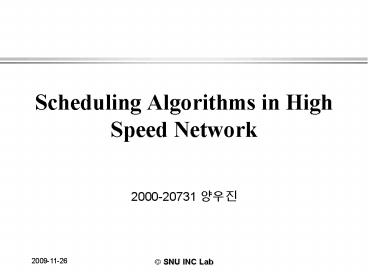Scheduling Algorithms in High Speed Network - PowerPoint PPT Presentation
1 / 23
Title:
Scheduling Algorithms in High Speed Network
Description:
Support a large number of sessions with diverse bandwidth requirement ... Situations when insertions into the list is needed (Re-calculate start time, finish time) ... – PowerPoint PPT presentation
Number of Views:55
Avg rating:3.0/5.0
Title: Scheduling Algorithms in High Speed Network
1
Scheduling Algorithms in High Speed Network
- 2000-20731 ???
2
Outline
- Introduction
- Goals
- Difficulties
- PFQ Algorithms
- Grouping architecture
- LBT / GBT
- For fixed length cells
- For variable length packets
- Timestamp Implementation
- Delay Result
3
Goals
- Support a large number of sessions with diverse
bandwidth requirement - Operate at very high speed
- Maintain important properties of GPS
- Guarantee an end-to-end delay to a
leaky-bucket-constrained session, regardless of
other sessions - Ensure fair allocation of bandwidth
4
Difficulties
- Key difficulty with PFQ algorithms
- require buffering on a per session basis and
non-trivial service arbitration among all
sessions - -gt Not scailable
- Arbitration needed(per session)
- Computation of the system virtual time
- Management of a priority queue
- Management of another priority queue to regulate
5
PFQ Algorithms(1)
- Complexity of calculating virtual time
- Accuracy and complexity trade-offs
6
PFQ Algorithms(2)
- Packet selection policy
- SFF(Smallest virtual Finish time First)
- SSF(Smallest virtual Start time First)
- SEFF(Smallest Eligible virtual Finish time First)
- Maintain a priority queue
- Number of entities in the priority queue is the
number of active sessions - Implementation complexity
- on-chip / off-chip
7
Outline
- Introduction
- Goals
- Difficulties
- PFQ Algorithms
- Grouping architecture
- LBT / GBT
- For fixed length cells
- For variable length packets
- Timestamp Implementation
- Delay Result
8
LBT / GBT
- LBT
- Bounds the differences of virtual start times
between two sessions in the same group - GBT
- Bounds the differences between the system virtual
time and virtual start time
9
Grouping Architecture for ATM Network(1)
10
Grouping Architecture for ATM Network(2)
- Restriction
- only a fixed number of guaranteed rates are
supported by the server - Sort by start time in the group
- Finish time is calculated
- Fi Si L/ri
11
Grouping Architecture for ATM NetworkChoose Next
Eligible Cell(1)
- Consider only the packets in the scheduler(head)
- SSF
- smallest S(.) in the scheduler
- -gt smallest S(.) among all packet
- SFF
- packet in the scheduler
- -gt smallest F(.) within the group
- -gt smallest S(.) within the group (because of
same rate) - SEFF
- eligible packet exist in the group
- -gt head packet is also eligible
12
Grouping Architecture for ATM NetworkChoose Next
Eligible Cell(2)
13
Grouping Architecture for ATM Network
Maintaining Within Groups
- Maintain a priority queue with a simple linked
list - Local timestamp bound(LTB)
- Stail Shead lt L/r
- Situations when insertions into the list is
needed - (Re-calculate start time, finish time)
- After finishing services head session
- A new session joins
- Idle session becomes active
14
Grouping Architecture for Packet Network
- Problem variable packet size
- Fi - Si L/ri (L is not determined)
- Smallest Si --X-gt Smallest Fi
- 2-D sort is needed
- By Fi Si (service interval Fi)
- By Fi
- Grouping by service interval
- Same service interval -gt same Fi-Si
- Large number of unused group
- Sessions change groups due to change of packet
length
15
Grouping Architecture for Packet
NetworkDiscretization of Service Interval
- Determine group
- group
16
Grouping Architecture for Packet NetworkProblem
with Discretization
- The maximum gap between time to be eligible and
computed virtual start time ( )
17
Grouping Architecture for Packet NetworkSorting
Within The Group
- Aproximated finish time
18
Outline
- Introduction
- Goals
- Difficulties
- PFQ Algorithms
- Grouping architecture
- LBT / GBT
- For fixed length cells
- For variable length packets
- Timestamp Implementation
- Delay Result
19
Timestamp Implementation(1)
- Size of timestamp determines
- The range of supportable rates
- The accuracy
- Memory requirements (bandwidth / storage space)
- Size of timestamp
- 1-bit larger than the largest service interval of
the largest rate in the system - Pf)
- With globally bounded timestamp property,
- largest gap of timestamps lt L/r (service
interval) - (n1 bit) needed for (2n) difference
20
Timestamp Implementation(2)
- Representations of timestamp
- V(t)429496678410 , high rate session i, low rate
session j - Fixed point
- Floating point
21
Timestamp Implementation(3)
- Compressed timestamp
- Sj V(t) Fj
- We only store CSj SjMej1ej
22
Delay Result
- ATM scheduling architecture(Proposed in this
paper) - A cell of session i will miss its deadline by no
more than - (transmit time of a ATM cell
- service interval of session I)
- Packet network architecture
- A packet of session j will miss its deadline by
no more than - (transmit time of maximum length packet
- the maximum gap between time to be eligible
and computed virtual start time - the maximum inflation of virtual finish time)
23
Summary
- Scalability problems with PFQ Algorithms
- Per session management
- Propose grouping architecture
- For fixed length cell grouping rate
- For variable length packet grouping rate and
length - Propose time stamp optimization
- Calculate minimum bit
- Propose compressed timestamp
- Delay Result































